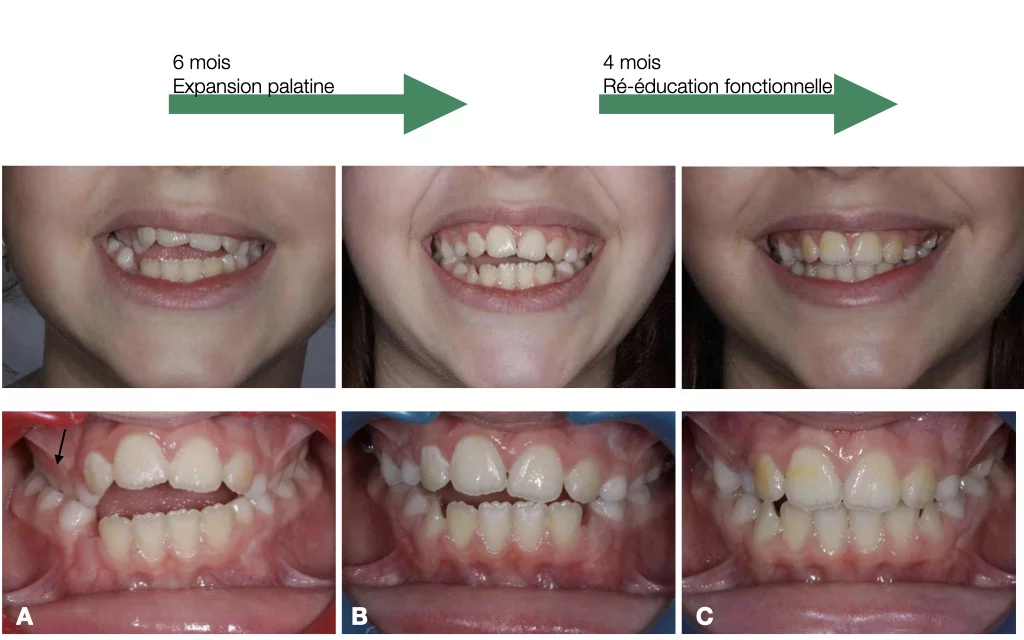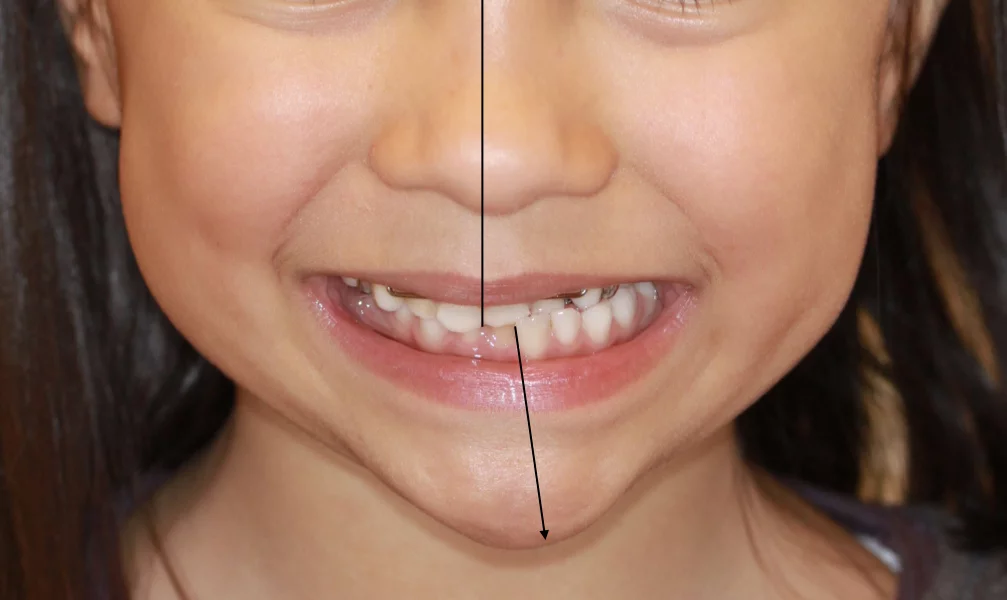More and more orthodontic specialists recommend early evaluations (from 3 years old). This preventive approach allows intervention before more complex and costly oral abnormalities develop.
Advances in technology and knowledge about oral development make it possible to prevent functional problems and promote jaw growth guidance from an early age.


WE
BUILD
THE FUTURE
OF SMILES
Very Young Children:
Prevention from 3 Years Old
At What Age Should You Take Your Child to the Orthodontist?
In a child’s early years, orthodontics can be used to correct certain disorders related to the development of oral functions. Indeed, orthodontics is the specialty that focuses on maxillofacial growth. Thus, in the context of normal development, the very young child will quickly acquire the function of breathing, then sucking-swallowing and chewing-swallowing with the appearance of the first molars, and finally speech articulation.
All these functions reach their full maturity between 3 and 6 years old. However, sometimes this development is hindered by abnormal growth of the jaws, or conversely, the appearance of dysfunctions or parafunctions prevents harmonious development of the bone bases and face. For example, thumb sucking or sucking on the lower lip are parafunctions that can limit the development of the maxillary bones, and consequently, future adult teeth.
The orthodontist, in consultation with the parents, will plan an appropriate strategy to prevent these problems from worsening. The purpose of this consultation is not to fit your child with braces, as only some children need early treatment.
Generally, a Comprehensive Examination of the Child is Carried out to Observe:
- proper jaw growth,
- the placement of their teeth,
- their general posture,
- the quality of their sleep,
- their oro-facial functions (swallowing, chewing, breathing, speech),
- any deforming habits (finger sucking, late bottle feeding, pacifier use, etc.).
Often, simple advice or very short and simple treatments allow your child to regain a functional mouth, which will not be limited in its growth in the coming years!
Information to remember: it’s never too early to seek an opinion!

Preventive Measures
Here are some effective preventive measures that most scientific societies recommend:
- Breastfeed, when possible: The breastfeeding method requires the infant to breathe through the nose. It therefore contributes to learning this mode of breathing. Conversely, when the baby takes a bottle, they can alternately swallow and breathe through the nose and mouth, as the bottle does not require an airtight lip closure or significant muscular work.
- Gradually teach the child to chew: From the appearance of baby molars between 12 and 18 months, with more resistant foods, such as mashed foods crushed with a fork, meat cut with a knife and not overcooked, fruits cut into small pieces. Avoid chewing on the same side all the time.
- Avoid thumb and pacifier: From the age of 3, the pacifier should stay in bed (for falling asleep). It is essential that the habit is stopped before 6 years old (arrival of the first adult teeth)!
- Monitor early: In families where there are jaw problems, consider early monitoring! This is how we give children’s mouths every chance of having a jaw capable of accommodating all teeth.
What should I Monitor in My Child?
Sleep
Does my child sleep well? Snoring? Frequent awakenings? Apneas? Daytime drowsiness?
Chewing
Does my child eat well? Do they have difficulty chewing?
Breathing
Does my child tend to breathe through the mouth?
Baby Teeth
Does the child have pointy canines? Do the baby teeth overlap? (normally there are spaces between baby teeth)
Jaw
Is the chin too far forward (with lower teeth overlapping upper teeth), or too far back (with the lower lip sucked under the upper incisors)? Does the lower jaw fit centered or shifted to one side (mandibular lateral deviation)? Do you see an open bite or, conversely, excessive incisor overlap?
Benefits of Early Intervention
- Favorable jaw growth
- Balance of dental arch width
- Improvement of eruption paths
- Reduced risk of trauma to protruding upper incisors
- Correction of oral habits
- Improved aesthetics and self-confidence
- Simplification and/or reduction of duration of subsequent corrective orthodontic treatment
- Reduced possibility of permanent teeth becoming impacted
- Improvement of certain speech issues
- Preservation or recovery of space necessary for permanent teeth eruption
- Improvement of child’s sleep, and consequently, improvement of their general health and concentration at school
- Reduced risk of developing obstructive sleep disorders (apneas, hypopneas, snoring) later

An early orthodontic evaluation will probably not avoid the need for further intervention later, but it can lead to simpler and more effective treatment for patients while reassuring them about their dental condition.
The dentist who refers their young patients at the right time is perceived by parents, rightly so, as a well-informed practitioner who cares about the well-being of their patients. Do not hesitate to ask your general dentist to refer your child to an orthodontist for a first evaluation.
Interceptive Orthodontics
From 6 to 11 Years Old
Performed between 6 and 11 years old, during the period when baby teeth and permanent teeth still coexist, they must prevent the jaws from growing crooked. The goal is to “avoid the development of problems that are difficult to manage later. It also allows” for a more conservative approach (avoiding extractions of permanent teeth and surgical interventions) and shortens the time braces need to be worn.
The objective is most often to correct a misalignment between the upper and lower jaws or an insufficient development of the jaws causing a lack of space. By widening the arch, we prepare space for the 12 permanent teeth that emerge between 10 and a half and 12 years old. At this stage, breathing should be strictly nasal. If problems persist, consulting an ENT is often useful to diagnose the presence of obstacles to proper breathing (adenoids / tonsils).
The appliances used (called interception appliances) can be fixed or removable, and worn for a period of 6 to 18 months depending on the severity of the anomaly. The important thing is to act at the right time in relation to growth, and to prevent the situation from worsening and becoming more complex to correct later. The interceptive treatment is followed by a break in treatment for several years before starting the comprehensive treatment when all adult teeth are in place.
The Action is Mainly at the Level of:
- Functions: general posture, tongue posture, breathing, chewing
- Skeleton and its growth: insufficient development of the maxilla or mandible, too narrow palate
- Teeth:reversed bite, missing tooth, dental eruption anomaly
The objective of all early treatments is functional and skeletal harmonization. Their real benefit is to allow the arrival of permanent teeth in good conditions, to ensure proper masticatory and respiratory function, and harmonious growth. This therapeutic phase will generally be followed and completed by a finishing phase of the occlusion when all permanent teeth are in place on the arch, the duration of which will be reduced.

Concrete Cases
Incisor Open Bite Caused by Thumb Sucking until the Age of 7

-
A. Insufficient transversal development of the palate (“narrow palate”) associated with an incisor open bite. Note the reverse occlusion. Mastication and speech are disturbed for this 9-year-old child.
-
B. Palate width corrected after 6 months of palatal expansion
-
C. Open bite corrected after functional re-education (posture and lingual function)
CauhéPé and Fieux Syndrome. Maxillary Endognathia Associated with Mandibular Latero-Deviation

INSIGHTS
Content for children
